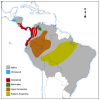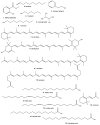Peach Palm (Bactris gasipaes Kunth.): Ancestral Tropical Staple with Future Potential - PubMed (original) (raw)
Review
Peach Palm (Bactris gasipaes Kunth.): Ancestral Tropical Staple with Future Potential
Nancy González-Jaramillo et al. Plants (Basel). 2022.
Abstract
A pre-Columbian staple, Bactris gasipaes Kunth. is a palm tree domesticated around 4000 years ago, so appreciated that a Spanish chronicler wrote in 1545, "only their wives and children were held in higher regard" by the Mesoamerican natives. The peach palm is an integral part of the foodways and gastronomy of Ecuador, Colombia, Bolivia, Peru, Brazil, and other tropical American countries; meanwhile, it is almost unknown in the rest of the world, except for hearts of palm. Although abundant, the species faces anthropogenic threats. The purpose of this study is to describe and summarize the physicochemical, nutritional, and bioactive characteristics of the peach palm and its two main alimentary products: hearts of palm and fruits, highlighting the functional and antioxidant potential of the latter, showing both ancestral and modern uses. There is active research on peach palm products and coproducts that aim for better, more sustainable uses of its traditional and recently found properties. The review and presentation of studies on this strategically relevant species can motivate the protection of endangered populations and stimulate new lines of research to advance development in the food, pharmaceutical, and cosmetic industries, with fair trade, sustainable development goals, and adaptation to climate change in mind.
Keywords: Amazon; Bactris gasipaes; food sovereignty; palm; phytochemicals.
Conflict of interest statement
The authors declare no conflict of interest.
Figures
Figure 1
Distribution of Bactris gasipaes Kunth., in tropical Central and South America. Grey: native; light blue: introduced (Trinidad and Tobago, El Salvador). Source: [19]. Shaded areas, main complexes: red: Occidental; green: Maracaibo; brown: Upper Amazonia; yellow: Eastern Amazonia. Source: [20].
Figure 2
Morphology of Bactris gasipaes: (A). Trunks showing internodes covered with thorns. Source: David Stang (CC BY-SA 4.0); (B). Difference between macrocarpa and microcarpa fruits; (C). B. gasipaes fruit, microcarpa variety, Cali Colombia. Source: Michael Hermann (CC BY-SA 3.0).
Figure 3
Phytochemical composition of Bactris gasipaes fruit. Major compounds.
Similar articles
- Understanding the Technical-Scientific Gaps of Underutilized Tropical Species: The Case of Bactris gasipaes Kunth.
Kramer YV, Clement CR, de Carvalho JC, Fernandes AV, da Silva CVA, Koolen HHF, Aguiar JPL, Nunes-Nesi A, Ramos MV, Araújo WL, Gonçalves JFC. Kramer YV, et al. Plants (Basel). 2023 Jan 11;12(2):337. doi: 10.3390/plants12020337. Plants (Basel). 2023. PMID: 36679052 Free PMC article. Review. - Full Exploitation of Peach Palm (Bactris gasipaes Kunth): State of the Art and Perspectives.
de Cássia Spacki K, Corrêa RCG, Uber TM, Barros L, Ferreira ICFR, Peralta RA, de Fátima Peralta Muniz Moreira R, Helm CV, de Lima EA, Bracht A, Peralta RM. de Cássia Spacki K, et al. Plants (Basel). 2022 Nov 21;11(22):3175. doi: 10.3390/plants11223175. Plants (Basel). 2022. PMID: 36432904 Free PMC article. Review. - Bactris gasipaes Kunth var. gasipaes complete plastome and phylogenetic analysis.
Buitrago Acosta MC, Montúfar R, Guyot R, Mariac C, Tranbarger TJ, Restrepo S, Couvreur TLP. Buitrago Acosta MC, et al. Mitochondrial DNA B Resour. 2022 Aug 26;7(8):1540-1544. doi: 10.1080/23802359.2022.2109437. eCollection 2022. Mitochondrial DNA B Resour. 2022. PMID: 36046105 Free PMC article. - An Integrated Hypothesis on the Domestication of Bactris gasipaes.
Galluzzi G, Dufour D, Thomas E, van Zonneveld M, Escobar Salamanca AF, Giraldo Toro A, Rivera A, Salazar Duque H, Suárez Baron H, Gallego G, Scheldeman X, Gonzalez Mejia A. Galluzzi G, et al. PLoS One. 2015 Dec 10;10(12):e0144644. doi: 10.1371/journal.pone.0144644. eCollection 2015. PLoS One. 2015. PMID: 26658881 Free PMC article. - Genetic differentiation and trade among populations of peach palm ( Bactris gasipaes Kunth) in the Peruvian Amazon-implications for genetic resource management.
Adin A, Weber JC, Sotelo Montes C, Vidaurre H, Vosman B, Smulders MJ. Adin A, et al. Theor Appl Genet. 2004 May;108(8):1564-73. doi: 10.1007/s00122-003-1581-9. Epub 2004 Feb 18. Theor Appl Genet. 2004. PMID: 14985969
Cited by
- Antiparasitic activity of Colombian Amazon palm extracts against Giardia lamblia trophozoites: insights into cellular death mechanisms.
García-Bustos JJ, Luna Pizarro G, Patolsky RG, Joray MB, Villalba-Vizcaino V, Galeano P, Espitia-Almeida F, Correa Múnera M, Ozturk M, Rópolo AS, Feliziani C, Touz MC, Laiolo J. García-Bustos JJ, et al. Front Microbiol. 2025 Mar 19;16:1523880. doi: 10.3389/fmicb.2025.1523880. eCollection 2025. Front Microbiol. 2025. PMID: 40177476 Free PMC article. - Understanding the Technical-Scientific Gaps of Underutilized Tropical Species: The Case of Bactris gasipaes Kunth.
Kramer YV, Clement CR, de Carvalho JC, Fernandes AV, da Silva CVA, Koolen HHF, Aguiar JPL, Nunes-Nesi A, Ramos MV, Araújo WL, Gonçalves JFC. Kramer YV, et al. Plants (Basel). 2023 Jan 11;12(2):337. doi: 10.3390/plants12020337. Plants (Basel). 2023. PMID: 36679052 Free PMC article. Review. - Five Underutilized Ecuadorian Fruits and Their Bioactive Potential as Functional Foods and in Metabolic Syndrome: A Review.
Duarte-Casar R, González-Jaramillo N, Bailon-Moscoso N, Rojas-Le-Fort M, Romero-Benavides JC. Duarte-Casar R, et al. Molecules. 2024 Jun 19;29(12):2904. doi: 10.3390/molecules29122904. Molecules. 2024. PMID: 38930969 Free PMC article. Review. - Edible Fruits from the Ecuadorian Amazon: Ethnobotany, Physicochemical Characteristics, and Bioactive Components.
Sánchez-Capa M, Corell González M, Mestanza-Ramón C. Sánchez-Capa M, et al. Plants (Basel). 2023 Oct 21;12(20):3635. doi: 10.3390/plants12203635. Plants (Basel). 2023. PMID: 37896098 Free PMC article.
References
- Aguirre Mendoza Z., León Abad N. Sobrevivencia y Crecimiento Inicial de Especies Vegetales En El Jardín Botánico de La Quinta El Padmi, Zamora Chinchipe. Arnaldoa. 2011;18:117–124.
- Clavijo J., Yánez P. Plantas Frecuentemente Utilizadas En Zonas Rurales de La Región Amazónica Centro Occidental de Ecuador. INNOVA Res. J. 2017;2:9–21. doi: 10.33890/innova.v2.n6.2017.180. - DOI
- Brito B., Paredes N., Vargas Y. Calidad y Valor Agregado de Los Frutales Amazónicos. In: Caicedo C., Buitrón L., Díaz A., Velástegui F., Yánez C., Cuasapaz P., editors. Proceedings of the Primer Congreso Internacional Alternativas Tecnológicas para la Producción Agropecuaria Sostenible en la Amazonía Ecuatoriana. Volume 1. Estación Central de la Amazonía INIAP; Orellana, Sacha, Ecuador: 2018. pp. 1–3.
- Toledo D., Brito B. Aprovechamiento Del Potencial Nutritivo y Funcional de Algunas Frutas de La Amazonía Ecuatoriana. Estación Experimental Santa Catalina; Quito, Ecuador: 2008.
- Vargas V., Clement C., Moraes M. Bactris Gasipaes (Arecaceae): Una Palmera Con Larga Historia de Aprovechamiento y Selección En Sud América. In: Moraes M., editor. Palmeras y usos: Especies de Bolivia y la Región. Universidad Mayor de San; La Paz, Bolivia: 2020. pp. 37–46.
Publication types
LinkOut - more resources
Full Text Sources


